



Student Learning Assessment (SLA) Direct Evidence of Student Learning (DESL) Fall 2019 Mo Bischof, Associate Vice Provost Regina A. Lowery, Sr. Assessment Coordinator Saundy Solum, AEFIS System Administrator, DoIT AT
Session Outline • Learning Assessment at UW-Madison • Integrating Elements of Student Learning Assessment (SLA) • “NEW” Direct Evidence of Student Learning (DESL) • Implementation Strategy • Observations, Feedback, Questions • Resources and Support
Why Direct Evidence of Student Learning (DESL)? Faculty and instructors evaluate student learning to answer key questions: • Are my students learning what I expect? • Are the course activities aligned with the learning outcomes? • What concepts or ideas need further explanation or delineation? • Are students making progress? • Overall, how will I know that learning has taken place? Direct assessments align with campus Learning Analytics efforts. Required for program-level assessment reporting.
Direct Evidence of Student Learning (DESL)
Direct Evidence of Student Learning (DESL) - Program and/or Course The DESL initiative allows faculty to digitally capture actionable learning data (evidence), within and across courses via Canvas/AEFIS integration: • Align and link course activities to learning outcomes • Create rubrics and evaluate student work • Access student data in real-time and over time– reports and dashboards • Use data to monitor student progress; adjust assignments or pedagogy • Inform students
Program Curricular Map - by Course
Program Curricular Map - by Outcome
Direct Evidence of Student Learning (DESL) In Canvas complete the following steps for Program and/or Course: ➔ Connect to AEFIS through Course Syllabus (AEFIS) ➔ Assignment Linking ○ Link Canvas assignments to CLO in AEFIS ➔ Grade throughout the semester ○ Enter grades in Canvas gradebook ○ Must use Canvas SpeedGrader if linking to specific question or Canvas rubric criteria ➔ Assessment Data ○ View individual data per student by CLO ○ View aggregate data by CLO
Program Student View - Comprehensive Learner Record
Comprehensive Learner Record
Comprehensive Learner Record
Comprehensive Learner Record
DESL Timeline 2017-2019 – Piloted program- level functionality (Pharmacy, etc.) - Feedback, upgrades and improved reporting and display features Summer/Fall 2019 – AEFIS develops course- level functionality, test phase Fall 2019 - Begin broader campus engagement - Resources: Introductory videos, KB, website presence - Engage “ready” faculty, instructors, instructional professionals, AEFIS admins - Engage leadership Spring 2020 – Implement Feedback
DESL Implementation Strategy: Launch and Sustain 1. ENGAGE “ready” courses and programs • Targeted Courses - REACH courses; General Education courses - CLO/Syllabus Incentive Departments (8-12 depts) - Blended@UW Winter 2019, Summer 2019 fellows - Online courses (TeachOnline) - Excel courses • Targeted Academic Programs - Marketing, Spanish, SoHE Online Personal Finance, General Education
DESL Implementation Strategy: Launch and Sustain 2. Engage S/C, departments, faculty, instructors and T&L professionals • Faculty and instructors • Instructional designers, specialists and instructional technologists (ITG, REACH, Excel) • Departmental AEFIS administrators • Leadership (UCAAA, ITG, LARC, UGEC, GFEC, etc.)
Observations. Questions. Discussion.
Student Learning Assessment Team Mo Bischof, Assoc Vice Provost and Director of Assessment mo.bischof@wisc.edu Steve Cramer, Vice Provost for Teaching and Learning steven.cramer@wisc.edu Regina Lowery, Sr. Assessment Coordinator regina.lowery@wisc.edu Saundra Solum, AEFIS Administrator saundra.solum@wisc.edu Michelle Young , APIR michelle.young@wisc.edu Kristy Bergeron, DoIT AT kirsty.bergeron@wisc.edu Caitlin O’Brien, EI Communications caitlin.obrien@wisc.edu Jon Orum, Project Manager jon.orum@wisc.edu https://assessment.provost.wisc.edu/ 35
THANK YOU . 36
Recommend
More recommend